#Judaic art
Explore tagged Tumblr posts
Text
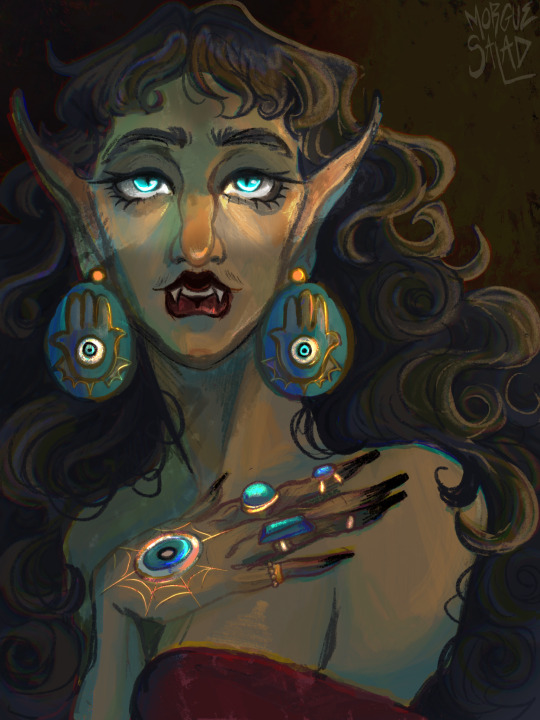
My character Eyphah from my story I’m writing about some silly vampires :) not de related sorry
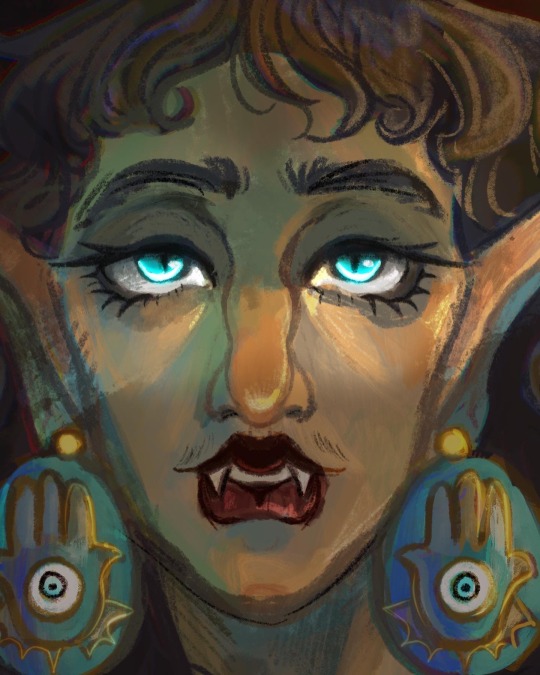
she is very eyes 👁️👁️🧿🪬
#art#illustration#digital art#portrait#digital painting#orginal art#oc#oc art#vampire#vampires#orginal story#orginal character#gothic Judaism#Judaic#Judaism#hamsa#evil eye#Judaic art
6 notes
·
View notes
Text
Dove Of Peace Colorful Bird Art Two
Beautiful botanical dove of peace by spiritual artist Sharon Cummings. Perfect for anyone who seeks a peaceful home or office space. Great for furnishings and accents for the Holidays as well. Spiritual and a symbol for all, even the non-faith based person. Of special meaning to the Christian or Jewish. The blessing of peace is for everyone. GET IT HERE!

View On WordPress
#art#christian#christian art#christian church#christian decor#christian gifts#christian home#christianity#Christmas art#christmas cards#Colorful Art#dove#doves#Hanukkah#Judaic#Judaic art#judaica#Judaism#peace#peace and love#peace art#peace sign#peaceful art#peaceful living#sharon cummings#sharon cummings art#white dove
0 notes
Photo

נהפוך הוא
#purim#purim holiday#jewish#jewish holiday#holidays#judaism#jumblr#judaic#art#artist#illustration#creature#festival#celebrate#jew
64 notes
·
View notes
Text

trying to put all my jewish feelings into something sweet
1 month until Rosh Hashanah, one of my favorite holidays
#the jewish experience tag#jews being jews#linocut#block printing#relief print#art#rosh hashanah#judaic new year
1 note
·
View note
Text
instagram
Step into a cozy bubble that brings us closer 🤍✨💫 Bring forth the light in us. Download Instantly at www.zebratoys.etsy.com
0 notes
Text
✨witch tip✨
did you know that each day of the week is magical? literally. each day of the week is ruled by a different planet and are associated with certain plants and herbs, crystals, incense, spell work, colors, deities, and elements! if you honor any deities in this list, this is a great way to honor them on the day they’re associated with!
Poster’s Note: if i left anything out or if i made any mistakes in this post please let me know and i will edit this post accordingly! 💕
~~~
•Monday
Ruled by: the moon
Element: water
Deities: Selene (Greek), Luna (Roman), Khonsu (Egyptian), Chandra (Hindu)
Colors: light gray, dark gray, light blue, purple
Crystals: opal, pearl, selenite, moonstone
Cast Spells For: intuition, justice, psychic work, fertility and femininity, healing, peace, spirit work/divination, sleep and dreaming
Plants/Herbs: chamomile*, water lily, orris, lotus, mint
Incense: sage, lavender, mugwort, lotus
•Tuesday
Ruled by: Mars
Element: fire
Deities: Ares (Greek), Mars (Roman), Tyr (Norse), Kali (Hindu), Lilith (Judaic/Hebrew)
Colors: red, orange, pink, black
Crystals: ruby, garnet, bloodstone, rhodonite
Cast Spells For: success, conflict/war/revenge, victory, breaking hexes and curses, protection, strength and courage
Plants/Herbs: holly, thistle, cactus, basil, coneflower
Incense: basil, patchouli, ginger, dragon’s blood
•Wednesday
Ruled by: Mercury
Element: air
Deities: Hermes (Greek), Mercury (Roman), Odin (Norse), Thoth (Egyptian), Krishna (Hindu), Lugus (Celtic)
Crystals: agate, citrine, sodalite, aventurine
Colors: orange, yellow, blue, purple
Cast Spells For: wisdom, healing, communication, money matters, art and creativity, travel and business, study and knowledge
Plants/Herbs: lilies, fern, eucalyptus, lavender, aspen
Incense: lavender, rosemary, cherry, clove
•Thursday
Ruled by: Jupiter
Element: earth
Deities: Zeus (Greek), Jupiter (Roman), Thor (Norse), Vishnu (Hindu)
Crystals: amethyst, turquoise, lepidolite, lapis lazuli
Colors: yellow, green, blue, purple
Cast Spells For: luck, ambition, success, happiness, abundance, wealth and prosperity, business and travel, loyalty and honor
Plants/Herbs: oak, honeysuckle, clove, sage, cinquefoil
Incense: cedar, sage, musk, cinnamon
•Friday
Ruled by: Venus
Element: water
Deities: Aphrodite (Greek), Venus (Roman), Freya (Norse), Hathor (Egyptian), Shukra (Hindu), Brigid (Celtic)
Crystals: jade, peridot, emerald, rose quartz
Colors: pink, blue, light gray, seafoam green
Cast Spells For: love and passion, harmony, balance, nature, fertility/motherhood, beauty and glamour
Plants/Herbs: saffron, coltsfoot, feverfew, pink rose, apple blossom
Incense: rose, apple, clove, strawberry
•Saturday
Ruled by: Saturn
Element: all elements
Deities: Kronos (Greek), Saturn (Roman), Loki (Norse), Geb (Egyptian), Shani (Hindu)
Crystals: obsidian, hematite, serpentine, apache tear
Colors: red, purple, light gray, black
Cast Spells For: banishing, protection, defense, cleansing, finding lost items, spirituality, wisdom, transformation, psychic attacks
Plants/Herbs: cypress, thyme, hemlock, myrrh, mullein
Incense: sage, opium, myrrh, sandalwood
•Sunday
Ruled by: the sun
Element: fire
Deities: Helios (Greek), Sol (Roman), Ra (Egyptian), Surya (Hindu), Lugh (Celtic)
Crystals: citrine, carnelian, amber, tigers eye
Colors: red, orange, yellow, gold
Cast Spells For: breaking habits, growth, success, decision making, confidence and strength, health and healing, self expression, prosperity and wealth
Plants/Herbs: sunflower, marigold, hibiscus, cinnamon, st. john’s wort*
Incense: lemon, cinnamon, opium, frankincense
*if you are currently taking birth control pills, DO NOT ingest the herbs with an asterisk next to them as they can make the pills less effective; i will have a list of what herbs and medications can make the pills less effective in a separate post!
#witchy#witchcraft#witch community#witch community tips#witchcraft tips#pagan witch#witchy tips#witchblr
46 notes
·
View notes
Text

The Kerubim, “The Strong Ones”
An “Angel” (Greek angelos or “messenger”) is considered to be a heavenly spirit, a messenger or intermediary between God or the gods and humankind. All religions possess one inherent commonality–the relationship of human beings with the Spiritual realm. In ancient Greek religion, Judaism, Christianity, and Islam, this relationship is thought to involve angels–divine messengers sent to humans to instruct, inform or command. An angel can function also as a protective guardian, as a heavenly warrior, and even as a cosmic power. Moreover, the line between a good angel and a bad angel, or demon, is sometimes unclear.
Therefore, angels can be broadly described as personified powers meditating between the Divine and the human. Even in its devotion to monotheism, ancient Israel was able to embrace the image of a council of gods by turning all of them into angels that serve the One God. This acceptance of a belief in angels was a development made relatively easy because lesser gods and angels could be referred to as “sons of God.” Later development in both Judaism and Christianity shows a remarkable growth of angelic folklore as a result of continuing this ancient practice of absorbing the gods of polytheistic religions by turning them into angels.
After the period of Israel’s Babylonian exile (597-538 BCE), Jewish thought about angels was considerably altered and enriched. Drawing on Mesopotamian art, artists and writers began to provide wings, even for the anthropomorphic angels, and an interest developed in angels’ garments, names, and relative ranks. In addition to the Mesopotamian influence, the Persian dualistic tradition of Zoroastrianism added another dimension to the Jewish conception of angels by positing hostile and destructive angels who are rebellious against God. The Jewish Qumran sect, or Essenes, saw the world as a battleground, the scene of the struggle between the Spirit of Truth and the Spirit of Wickedness, the latter an angelic power opposed to God called Belial or more commonly, the “Devil.”
In Judaic Angelology, there are nine classes of Angels: the Seraphim, Kerubim, Thrones, Dominations, Powers, Virtues, Principalities, Archangels and Angels. According to Henry Cornelius Agrippa, in his Three Books of Occult Philosophy, aspects of the Elements can be attributed to the natures of these orders of Angels as follows: Fire to the Seraphim, Authorities and Powers; Water to Thrones and Archangels, Air to the Dominations and Principalities, and Earth to the Kerubim. Placed in superior hierarchy are the supercelestial angels, who, mediating the pattern of Divine Will, are: the Thrones as the Wisdom of God; the Seraphim as the Goodness of God, and the Kerubim as the Essence and Form of God. As stated by Agrippa, from the Angelic Orders humankind is strengthened with extraordinary attributes.
“From the Angels, Mankind perceives messages of Divine Will and a clearer comprehension of the Mind of God. From the Archangels, humanity obtains rulership over beasts of the field, fish of the sea and fowl of the air.”
From the Principalities, all things are overcome, engendering a comprehension of the ascendancy of all things, and drawing spiritual power to oneself by a secret and divine force. From the Virtues come the power and strength against enemies of Truth. From the Powers, the ability to conquer these enemies within ourselves. From the Dominations, subjugation of these adversaries. From the Thrones we are woven together and collected into ourselves with remembrance fixed on Eternal Visions. From the Seraphim we acquire the perfect flame of Love, and from the Kerubim comesthe light of mind, the power of wisdom, and the exalted images by which we contemplate the Divine.
As stated in Three Books of Occult Philosophy, the Hebrew theologians numbered and called these orders as follows: in the supreme province, are the Chayoth ha Qodesh, or Creatures of Sanctity, to which EHEIEH gave the gift of life. In the second place are the Auphanim, Forms or Wheels, whereby YHVH differentiated the chaos. In the third place are the Aralim, great, strong and mighty angels, by which YHVH joined with Heh (HHYVH) to provide form to the liquid matter. In the fourth place are the Chasmalim by which AL framed the image of bodies. In the fifth order are the Seraphim by which ELOHIM GIBOR drew forth the elements. The sixth are the Malachim which ELOAH produced metals. In the seventh sphere are the Elohim or Gods, by which YHVH TZABAOTH produced vegetation. In the eighth reside the Beni Elohim, Sons of Gods, by which ELOHIM TZABAOTH produced animals. The ninth and lowest sphere contains the Kerubim by which SHADDI EL CHAI created Mankind.
The above has been a short introduction into the realm of Angels. The subject of the Kerubim alone could involve voluminous amounts of information as there are many different classes and functions of the Kerubim–they are not simply limited to the Sephirah of Yesod. The Elements have their analogies at every level, and these attributions can be applied to every Sephirah, but particularly the central Sephiroth on the Middle Pillar. The Kerubic forces of Kether descend the central Column from Kether to Malkuth. This is indicated by the Kerubic signs about the corners of the Tarot Trump XXI, The Universe. Malkuth is the sphere of the Elements and Yesod is its foundation, which, being on the Second Plane, is the sphere of contact with Natural Forces. Tiphareth is the Sephirah from which the Elements are controlled, the Sephirah of the Elemental Kings (Elementals which have begun to respond to Spiritual vibrations).
The Seraphim (derived from the word “Seraph” meaning “burn”) are another class of angels considered to be an upper octave of the Kerubim. Their function is to burn false doctrine and convert man back to righteousness. It is said that they pass on information drawn from the Neschamah during sleep, to the Creator in Atziluth, for the Seraphim are the Holy of Holies, or the Highest Heaven in Briah.
The focus of this paper, however, covers only those Kerubim which include Gabriel, the Angelic Choir of the Kerubim of Yesod, the Archangels of the Elements, and the Right and Left-Hand Kerubs, Metatron and Sandalphon.
Gabriel
Gabriel’s name comes from the same Hebrew root as Geburah (GBR) indicating a relationship between the 5th and 9th Sephiroth. Gabriel serves a triple function, Annunciator, Guardian and Guide. Gabriel is the divine messenger who relays information between the Divine and humanity and bestows the gifts of vision, hearing and psychic abilities as well as the powers of life, procreation and equilibration. This angel is referred to as Gabriel Yesodel (Archangel of Yesod) and as Gabriel Kerubiel (leader of the Kerubim).
As an angel of high eminence in Jewish, Christian and Muslim tradition, Gabriel is one of the four most often noted in Judaism and Christianity, the others being Michael, Raphael and Uriel. Gabriel is the heavenly messenger who appears in order to reveal God’s will. In the Old Testament, Gabriel interprets the prophet’s vision of the ram and the he-goat (Daniel 8:15-26) and explains the prediction of the 70 weeks of years (490 years) for the duration of the exile from Jerusalem (Daniel 9:21-27). In the New Testament, Gabriel announces to Zacharias the birth of his son, John, who is destined to become known as John the Baptist (Luke 1:11-20), and in Luke 1:26-31 reveals to Mary that she is to be the mother of Christ. Among Muslims, Gabriel is believed to be the spirit who revealed the secret writings to the Prophet Mohammed. As the Annunciator, Gabriel is most likely to speak to us through dreams.
Gabriel means “Strong one of God” or “Strength of God.” As seen by the position of Yesod on the Tree of the human psyche, the name is not without reason. From the position on the central Pillar of Consciousness on the Tree, Gabriel is the firm and stable foundation of the Spirit. As Yesod in the World of Briah, it is the ego consciousness of Briah, and the Sephirah occupied by Gabriel is a crucial one. It is the last stage before the aspirant reaches the Kether of incarnation, or the Tiphareth of Briah, for beyond lies the threshold between Raphael in Hod and Haniel in Netzach. At this point, he is still Man but may be referred to as “Hero of God” under the guidance of Gabriel. To pass, the initiate must rise up the Tzedek Path of Righteousness where the shadow side of the personality is destroyed, and all remnants of being as a separate entity are dissolved. Only then can one attain Tiphareth in Briah and come under the direct influence of Archangel Michael, or “One Who Is Like Unto God.”
The Kerubim
The Kerubim can be conceived of as a reflection of the Four Holy Living Creatures of Kether, the powers of the Eternal Elements. The duty of the Chayoth ha-Qodesh is to formulate the primary pattern upon which the rest of existence is built. These Kerubic forces descend the Middle Pillar to Yesod where the Kerubim, as the structural powers of the Universe, support this existence. Therefore, the Kerubim are the formative powers of the Elements stationed in the sphere of Yesod, the etheric substructure that supports the physical universe. As these etheric powers, the Kerubim are the formative forces of the world and humankind. As Angels of Lunar Yesod, the Kerubim also have an association with time, the four Kerubic points in the year which are the Hermetic Qabalah’s cross quarter days. Their name means “the Strong Ones” which is derived from the Akkadian word Karibu which means “one who prays” or “one who intercedes.”
The work of the Kerubim is to influence communication between the inner and outer worlds by serving as Guardians, Heralds, Equilibrators and Guides. They work on the building of knowledge and the harnessing of force in etheric or Yesodic methods. One of these methods is the use of symbols relating to Yesodic perception within the depths of the unconscious mind. With the progression of time, these symbols become less ritualistic and more psychic, becoming tools in the hands of the aspirant. These images are the contents of the Treasure House of Images, and the forces behind these images are the Angels of Yesod.
The Tetradic Kerubim are the animated powers of YHVH working through the fixed signs of the Zodiac. As given in Exodus 25:18-19 and 37:9, their shapes represent the aspects of the four dynamics of the Elements. These energies are not the Elements themselves, but rather are placed between the Angels and the Elements in hierarchy. One of the functions of the Kerubim is to take these energies and set them into motion and as such,, this Choir of Angels has a direct affect on the Earth and Man. As presidents of the Elemental Forces, these Four Kerubim are each assigned one of the letters of the Divine Name YHVH, and they operate in and through the four astral Elements in Yesod before these Elements are formulated in the physical world of Malkuth.
This Tetrad serves as Equilibrators by creating a stable nucleus from which the physical world comes forth into being. These four Vice-Gerants of the Elements, under the Presidency of Spirit (Gabriel), are synthesized in the formula of YHSHVH. Yod, Lion, Nequaquam Vacuum, Nowhere a Void; He, Eagle, Libertas Evangelii, Liberty of the Gospel; Vau, Man, Dei Intacta Gloria, Unsullied Glory of God; and Heh (f), Ox, Legis Jugum, Yoke of the law; and in the midst of the four letters is Shin, the letter of Spirit, which, formed from the Tetragrammaton, gives the Divine name of Yeheshua, The Pentagram represents the concentrated force of the Spirit and the four Elements governed by the five letters of the Name of the Restorer, YHSHVH and is not only attributed to the planet Mars, but also shows the Kerubim and the Wheel of Spirit. The Kerubim of Ezekiel have four faces, those of the Lion, the Bull, the Man and the Eagle, alternating with each other by rotation. Beside them was the symbolic form of the Spirit, symbolized by the wheel. As suggested by the two wings that covered their bodies and the two wings that stretched upwards to each other, the synthesis of the Kerubim is found in the revolving Cross, in the Pentagram, and in the idea Spirit dominating the four Elements.
The Kerubim are winged celestial beings which, unlike most conceptions of angels as anthropomorphic, are zoomorphic. On the 32nd Path between Malkuth and Yesod, the Zelator encounters these Four Kerubim who perform elemental purifications which aid in the alchemical transformation of the aspirant. In this ritual, the aspirant learns that the Elemental Spirits are invoked through the power and governance of the Kerubim and their Zodiacal symbols. They are given Hebrew names but their appearance is primarily Egyptian:
Adam (Hebrew for Man), Kerub of Air, stationed in the East, human-headed Aquarius. “The Priest with the Mask of Osiris spake and said, ‘Thou canst not pass the Gate of the Eastern Heaven unless thou canst tell me my name’.” of which is replied “Thou art NUT, Goddess of the Firmament of Air. Thou art HORMAKU, Lord of the Eastern Sun.”
Aryeh (Hebrew for Lion), Kerub of Fire, stationed in the South, Lion-headed Leo. “The Priest with the mask of the Lion spake and said, ‘Thou canst not pass the Gate of the Southern Heaven unless thou canst tell me my name’.” Of which is replied, “Thou art MAU the Lion, Very Powerful Lord of Fire. Thou art RA, the Sun in his strength.”
Nesher (Hebrew meaning Eagle), Kerub of Water, stationed in the West, Eagle-headed Scorpio. “The Priest with the mask of the Eagle spake and said, “Thou canst not pass the Gate of the Western Heaven unless thou canst tell me my name’.” of which is replied “HEKA, Mistress of HESUR, Ruler of Water, is Thy name. Thou art TOUM, the Setting Sun.”
Shor (Hebrew meaning Bull), Kerub of Earth, stationed in the North, Bull-headed Taurus. “The Priest with the mask of the Ox spake and said ‘Thou canst not pass the Gate of the Northern Heaven unless thou canst tell me my name’.” of which is responded, “SATEM, in the abode of SHU, the Bull of Earth, is Thy name. Thou art KEPHRA, the Sun at Night.”
The arrangement of the Theoricus Hall of only four officers suggests the conciliatory Element of Air reconciling the opposing energies within the Hall, resulting in a perfect balance of forces. The number four is associated with Chesed, the first Sephirah to manifest below the Abyss, but it also refers to Yesod as the firm foundation within which the Four Elements are given etheric form which then later materialize in Malkuth during the course of the Lightning Flash.
In the Theoricus Ritual, as the Hierophant addresses the candidate on the meaning of the Cross within the Triangle, it is stated that the Cross, placed upon the Altar at the base of the Tree of Life, refers to the Four Rivers of Paradise. It is Gabriel who rules the “Living Water streams that well from out the Highest Throne.” “…And he showed me a pure river of the water of life, clear as crystal, proceeding out of the throne of God and of the Lamb.” (Revelations 22:1). These Rivers are referred to in Genesis 2:10-14: “And a River, Nahar, went forth out of Eden to water the Garden, and from thence it was parted and come into four heads. And the name of the First River is Pison, it is that which compasseth the whole land of Havilah, where there is gold. And the gold of that land is good. There is Bdellium and the Onyx stone. [–Leo.] And the name of the Second River is Gihom, the same as that which compasseth the whole land of Ethiopia. [–Scorpio.] And the Name of the Third River is Hiddekel, that is it which goeth forth to the East of Assyria. [–Aquarius.] And the Fourth River is Euphrates. [–Taurus.]” This indicates the Presidency of Spirit (Gabriel) over the four Elements.
In the Zelator Ritual the aspirant is told. “And Tetragrammaton placed Kerubim at the East of the Garden of Eden and a Flaming Sword which turned every way to keep the Path of the Tree of Life, for He has created Nature that Man, being cast out of Eden, may not fall into the Void. He has bound Man with the Stars, as with a chain. He allures him with scattered fragments of the Divine Body in bird and beast and flower, and He laments over him in the Wind and the Sea and in the Birds. When the times are ended, He will call the Kerubim from the East of the Garden, and all shall be consumed and become Infinite and Holy.” …. “This drawing of the Flaming Sword of the Kerubim is a representation of the Guardians of the Gates of Eden.
As the Qabalah teaches, the everlasting abode of the Higher Self is in the Eden of Paradise, the supernal sanctuary which is forever guarded from chaos by the Flaming Sword of the Kerubim whirling across borders of the Abyss. After the descent from Grace, the Kerubim were stationed at the Abyss to separate the Supernals from the effects of the Fall.
The Four Kerubim, through their assignation to the four Archangels, are Four of the Seven in the Presence of the Lord. This description of the Kerubim is from John’s vision (Revelations 4:7-8): “And the first beast was like a lion, and the second beast like a calf and the third beast had a face as a man, and the fourth beast was like a flying eagle. And the four beasts had each of them six wings about him; and they were full of eyes within: and they rest not day and night saying, ‘Holy, Holy, Holy, Lord God Almighty, which was, is and is to come.’ ” Here, the Kerubim are seen as single-headed but having six wings, thus uniting the powers of the number seven (the Planets) with the number four (the Elements).
The Invisible Stations of the Hall of the Golden Dawn
The Stations of the Man, the Lion, the Bull and the Eagle are the Four Cardinal Points without the Hall and these are the invisible Guardians of the boundaries of the Temple. They are placed according to the Four Winds and are stationed beyond the thrones of Hierophant, Dadouchos, Hiereus and Stolistes.
The Kerub of Air, behind the throne of Hierophant, is the power of the Goddess Hathor who unites the powers of Isis and Nephthys. The sign of Aquarius, the zodiacal sign of Air, is the Water-Bearer, the container of Rain. The Egyptian name for the Sign of Aquarius is Phritithi.
The Kerub of Fire, face and form of a lion, with large, flapping wings, is behind the throne of Dadouchos, and is the power of the Goddess Tharpesh or Tharpheshest. The action of the Lion Kerub is through the Flaming Fire of Leo with the Egyptian name of Labo-Ae.
The Kerub of Water, which has the face and form of a great Eagle with large, glinting wings, is behind the throne of Hiereus. It is the power of the God Thoomoo, and his operation is through the Sign of Scorpio, which is called in Egyptian Szlae-Ee (in Egyptological works the name of this god is Tum or Tmu).
The Kerub of Earth has the face and form of a Bull with heavy, dark wings and is situated behind the throne of the Stolistes. It is the power of the God, Ahaphshi, operating by the Sign of Taurus and its Egyptian name is Ta-Aur.
Sphynx, the Synthesis of the Kerubim
The Sphynx is a synthetic of the Kerubic figures. In the Ritual of the 32nd Path leading into the Theoricus Grade, it is written, “The Sphynx of Egypt spake and said, ‘I am the synthesis of the Elemental Forces. I am also the symbol of Man. I am Life. I am Death. I am the Child of the Night of Time.’ ” As stated in Regardie’s Golden Dawn: “Now learn the mystery of the Wisdom of Egypt: ‘When the Sphynx (synthesis of the Kerubim) and the Pyramid (synthesis of the Elements) are united, thou hast the formulae of the magic of nature. These are the keys of the wisdom of all Time; and its beginning–who knoweth it? In their keeping are the sacred mysteries and the knowledge of Magic and all the Gods.”
According to Levi in Transcendental Magic: “You are called to be the king of air, water, earth and fire, but to reign over these four living creatures of symbols, it is necessary to conquer and enchain them. He who aspires to be a sage and to know the Great Enigma of Nature must be their heir and despoiler of the Sphynx, his the human head, in order to possess speech; his the eagle’s wings in order to scale the height; his the bull’s flanks in order to furrow the depth; his the lion’s talons, to make a way on the right and the left, before and behind.”
The Kerub, or Symbolic Bull, which Moses placed at the gate of the edenic world bearing a fiery sword, was a Sphynx which had a bull’s body and a human head. It is the Assyrian Sphynx, symbolic of the combat and victory of Mithras. This armed Sphynx represents the Law of Mystery who watches at the door of initiation to warn away the profane.
The Mosaic Kerub also represents a great mystery in which the elements are expressed by the number seven, without, however, giving the final word. This word is what the Qabalists write as YHVH and interpret by Aleph Resh Aleph Resh Yod Tau Aleph, expressing the triplicity of the secondary principle, the alliance between the triad and the tetrad, in a word composed of four letters, which form seven by means of a triple and double repetition. This word is pronounced “Ararita.”
The universal key of all magical operations is that of the ancient religious doctrines, and it is the key to the Qabalah, the Bible, and the Lesser Key of Solomon. With this key, we are able to understand the enigmas of every Sphynx and penetrate the Mysteries–and the key is this: (1) a hieroglyphic and numerical alphabet, expressing by characters and numbers, a series of universal and absolute ideas, (2) a scale of ten numbers, multiplied by four symbols and connected with twelve figures representing the twelve signs of the zodiac and (3) the four angels of the cardinal points.
The symbolic tetrad, represented in the Mysteries of Memphis and Thebes by the four forms of the Sphynx, i.e. the man, eagle, lion and bull, correspond to the four elements. Now these four signs, with all their analogies, explain the one word hidden in all the Mysteries. It is the name of the four primal letters of the Ineffable Name: YOD, symbol of the paternal scepter of Noah; HE, the cup of libations and also symbolic of maternity; and VAU which emerges from and joins the two. This is the triple sign of the triad in the Divine Word; but the mother-letter, HE appears a second time, to express the fertility and abundance of Nature and of woman to concisely express the doctrine of universal and progressive correspondences, which descends from cause to effect and ascends from effect to cause. Moreover, this sacred word is not pronounced, it is spelled, and expressed in four letters which are the four sacred words, Yod He Vau He.
Metatron and Sandalphon
One of the most common appearances of the Kerubim is the great dyad of Metatron and Sandalphon. These two holy Kerubim are the Sentinels of the Briatic Mother Temple of Light. Metatron is the Great Masculine Kerub, corresponding to the White Pillar of Yakhim, and Sandalphon is the Great Feminine Kerub, corresponding to the Black Pillar of Boaz. These Two Pillars, positioned on the right and left sides of the Tree, are symbolic of the concepts of Active and Passive, Male and Female, Adam and Eve and refer to the Pillars of Fire and Cloud which guided the Israelites in the wilderness. In the Theoricus Ritual, the hot and moist natures are further marked by the Red Lamp and the Cup of Water. These Two Kerubim are the Angels of the Devir, the Holy of Holies of the Hebrew Tabernacle and Temple. In this Temple, one inunense pair of Kerubic Images spread their wings from wall to wall and a smaller pair stood at the two ends of the Ark itself. Between them was the Kaporeth, the Presence of Yahweh.
Eheieh denotes breath and the sound that every being pronounces all its existence, and it is the Name of the Lord of Life. By the inspiration and expiration of Eheieh through the two Great Pillars (Macroprosopus is Aima and Abba, Mother and Father), all things are thrown into vibration. As Guardians over Malkuth, Metatron and Sandalphon are the Two Pillars, but the work of these Dyadic Kerubim is not solely relegated to the role of Guardians. They function also as Equilibrators, balancing opposites and defining the center, the place of balanced power. As Equilibrators, these Two Kerubim are closely related to the Egyptian Godforms of Isis and Nephthys. Nephesch ha-Messiah (also called “Kerubim”) is the animal soul of Messiah, or the Shekinah, and is the Presence between these two Kerubim. The Shekinah represents Aima Elohim, the Supernal Sephiroth as a synthetic unity of the Divine White Brilliance. Since this is spoken of as between the Kerubim, it is the Middle Pillar of the Tree and as such, is the Path of the Redeemer.
The vibrations of the Briatic World of Kether are shown through the influence of the mighty Archangel Metatron, the Great Angel of the Presence and the World Prince. Also called the “King of Angels,” Metatron was the guiding angel that led the children of Israel through the wilderness. Metatron, alone, sees the Face of God. He presides over the Tree of Life in its entirety and is considered the Right-hand Masculine Kerub of the Ark. It is said that Metatron communicated the Qabalah to humankind, and as stated in the Abodah Zarah of the Talmud, he is the “teacher of the prematurely dead children of Paradise.” He is known as the Metatron Ketheriel and is also called IOEL – “I am God.” Metatron functions as the link between God and Man, and the vibration of this Archangel’s name will generate a yearning to return to God or the pure state of Kether. Therefore, he is the guide or source of aspiration in attaining the higher levels of the self and by vibrating his name, we draw down that part of him to aid us in this effort.
The effect of the Briatic World of Malkuth is through the Archangel Sandalphon. She is also the Left-hand Kerub of the Ark of the Covenant. Translated from the Greek “Sandalfon” which means “Co-Brother,” Sandalphon is considered the twin of Metatron or another form of this Archangel. Another translation of the name is “Lord of the Extent of Height” and because of this remarkable height, she is said to be able to reach her twin in Kether, which points to the idea that Malkuth is Kether–but after a different manner. As the Archangel of Malkuth, Sandalphon reconciles the material energies which are brought forth into the physical world. She is also said to convey the power and beauty of the natural world to the Souls of humanity and influences worldly affairs in general by creating the building blocks and designs for each civilization.
On the Microcosmic Tree of Life, Malkuth of Briah is the equivalent to the self of Man. The archangel Sandalphon watches over the Kether (the most spiritual essence) of the physical body and the Tiphareth (the consciousness) of the psychologically unawakened individual. When initiates begin to evolve, Sandalphon guards them as the Neschamah grows, always keeping consciousness on the Middle Path. As the Neschamah becomes stronger, an image of the Briatic World, the realm of Spirit, begins to form. Slowly a foundation is formed on the lower portion of the Briatic Tree, and the initiate begins to perceive and comprehend the images of this World, as is demonstrated by the Chariot and Throne of the vision of Ezekiel. It is here that the creation of a purified consciousness is originated, and with this fusion of consciousness comes the development of an awareness in the Ruach triad. When the crystallization is complete, when it is stable within, it is no longer a passing flash or a gift, but a permanent foundation.
Conclusion
The word “Kerubim” might be better understood as a matter of function, rather than as a title, indicating the working together of groups, or polarities, i.e. dyads, tetrads, enneads, etc. Viewing the Tree as functioning simultaneously, the Elements originate in Kether through the Fylfot or the Spiral–“God breathes.” Chokmah is the pure, inexhaustible force of this “breath,,” and Binah is its vehicle of definition. These two Sephiroth originate the channel whereby the Kerubic forces descend the Middle Pillar, and the Side Pillars maintain this passageway through which they move. These Elemental forces are drawn forth across the Abyss by Geburah, working in conjunction with Chesed which equilibrates them, and it is these two Sephiroth which bring these forces through to individualized potential. They are then manifested as the heart of self through Tiphareth which rules and controls them. Netzach and Hod duplicate the efforts of Chokmah and Binah and of Geburah and Chesed in the lower personality of the self; and it is in Yesod, or the ego consciousness, that these Kerubic forces are structured. Malkuth is the manifestation of these elements within the physical body, the grounding of the circuit. The function of the Kerubim seems to be in guarding the gate of this action.
art: Spitblossoms
54 notes
·
View notes
Text

Esther
Artist: Jean-François Portaels (Belgian, 1818-1895)
Date: c. 1869
Medium: Oil on canvas
Collection: Art Gallery of New South Wales, Sydney, Australia
Description
Here Portaels paints one of the heroines of the Hebrew Bible, Esther. She was the beautiful Jewish wife of the Persian king Ahasuerus (Xerxes I). On learning of her husband's plans to annihilate the Jews throughout his empire - a massacre plotted by the king’s chief minister, Haman - Esther and her cousin Mordecai persuade Ahasuerus to retract the order. On the day planned for the annihilation, instead the Jews destroyed their enemies. The date of the massacre was to have been decided by casting lots ('purim'), which is said to have given the name to the annual celebration of Purim. The story is set out in the Book of Esther, in the third section of the Judaic canon known as the Ketuvim or “Writings” in the Hebrew Bible, and in the Christian Old Testament.
#painting#queen esther#oil on canvas#jewish#book of esther#christianity#jean francois portaels#belgian painter#19th century painting#female#queen#royal robes#jewish costume#belgian art#artwork#holy bible#biblical
45 notes
·
View notes
Text
This is an Anti-Robert Graves Blog
While researching Robert Graves White Goddess thing to make sure I understood the claims I have realized just how intensely stupid it is, more so than I realized.
Ableist: "Graves believed that one could be in the true presence of the White Goddess when reading a poem, but in his view, this could be achieved only by a true poet of the wild, and not a classical poet, or even a Romantic poet, of whom he spoke critically: "The typical poet of the 19th-century was physically degenerate, or ailing, addicted to drugs and melancholia, critically unbalanced and a true poet only in his fatalistic regard for the Goddess as the mistress who commanded his destiny".[3]" — From wikipedia's page on the book
Racist: "The whiteness of the Goddess has always been an ambivalent concept. In one sense it is the pleasant whiteness of pearl-barley, or a woman’s body, or milk, or unsmutched snow; in another it is the horrifying whiteness of a corpse, or a spectre, or leprosy…. [p. 361]" & "The Goddess is a lovely, slender woman with a hooked nose, deathly pale face, lips red as rowan-berries, startlingly blue eyes and long fair hair [p 10]" .... dude what the fuck.
Eurocentric: "Poetry began in the matriarchal age, and derives its magic from the moon, not from the sun [p. 372]" Art comes from the moon! And the moon is a woman! Meanwhile Anatolia and Japan both have Female Sun deities. The Supreme deity of the Hittite's is The Sun Goddess of Arinna. One of the highest Kami, rulers of Japan trace their ancestry to her, is the Sun Kami Amaterasu-Ōmikami. But those cultures don't count, they don't have deathly pale faces with red lips, and startling blue eyes like the White Goddess does. Also what about the cultures with male moon Gods. Again Japan has Tsukuyomi-no-Mikoto, Mesopotamia has Nanna and Sin, Elam has Napir. No poets came from those cultures? Robert are you just that fucking unlearned—while pretending to be a learned scholar—and racist?
Extremely Anti Semetic: "The third stage of cultural development–the purely patriarchal, in which there are no Goddesses at all–is that of later Judaism, Judaic Christianity, Mahomendanism and Protestant Christianity…. [p. 322]" & "Now the Jews are fast turning “liberal” and both they and the Christians are further away than they ever were from the ascetic holiness to which Ezekiel and his Essene successors hoped to draw the world, and after many theological ups and downs we have come to be governed by the unholy triumvirate of Pluto god of wealth, Apollo god of science and Mercury god of thieves….Unless the ascetic Michael can quickly reorganize his scattered legions of angels for a new puritannical campaign of sexless unworldliness, there can be no escape from the present more than usually miserable state of the world [pp 390-1]" did he seriously just say that the shitty state of the world is all the Jews fault because of their male God .... in 1948.
Part of me wants to actually read this book to appreciate how fucking stupid it is. I don't want to waste my money I don't have a digital copy on my library app :\
Wikipedia
Quote Source
17 notes
·
View notes
Note
i feel like ive just gotten baited into sending one of those "WAIT, KIRBY HAS DEEP LORE!?" asks but please tell me about the magolor christian themes
HELLO. ok it is 2am so i will do the best i can. if this answer is utterly incoherent, blame that.
magolor's whole christian thing has been around since his concept art, which ensured that his design had notable yellow highlights as a nod to the color used to represent judas in classical christian art. (his ears were also originally going to be horns, so there could be some devil stuff there if you squint.)

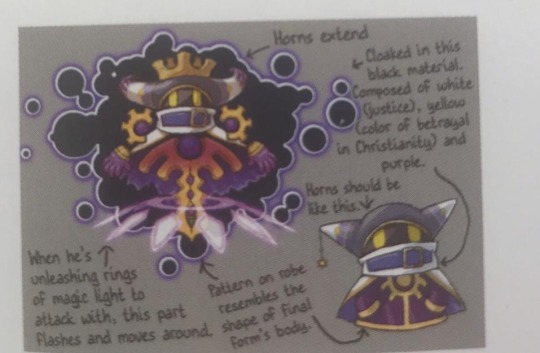
this doesn't mean much if you only look at return to dreamland 2011. it's simply a clever, blink-and-you'll-miss-it piece of his character design that ties with the fact that he betrays kirby. some fans also found this funny regarding his symbolic link to apples, which he uses as bombs or. uh. microtransaction materials. lol.
however, once return to dreamland deluxe came out in 2023, the game dropped a MASSIVE bomb of their own by providing us with a new, post-game epilogue for magolor. spoilers ahead, obviously. via the epilogue, magolor's link to apples is explored in-depth by putting him through trials where he must collect 5 fruit (apple) fragments, which a game screen implies parallel the fact that magolor tricked kirby into collecting the 5 parts of the lor starcutter. that's essentially his "penance" process.
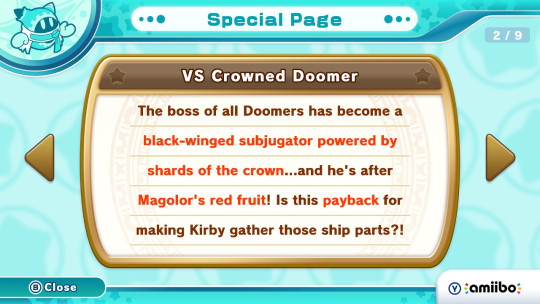
when magolor finished rebuilding the apple, which is known as the "ethereal alter" in english and the very unsubtle "room of eden" in japanese. the master crown that magolor had betrayed kirby for and stolen from its place on halcandra became a massive gem apple tree final boss. however, the tree itself is not listed as the boss--instead he is fighting the master crown itself.
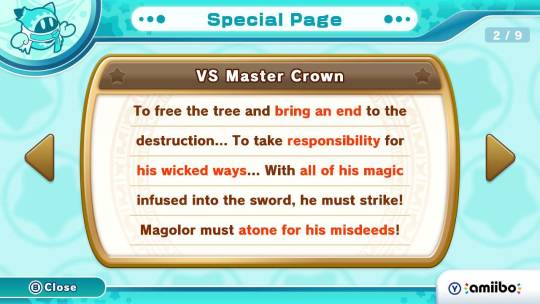
he ultimately destroys the master crown, which had taken the form of the "forbidden fruit" that had tempted magolor into hurting people, including those he had come to genuinely deem friends, for the sake of obtaining personal power. the gem apple being constructed in the "room of eden" is enough on its own to build a base for a christian theme, but magolor's arc of redeption through either 1. trial and repentance (main gamemode with magolor epilogue; self-imposed; successful) 2. outside aid (extra mode + true arena; extended by kirby; failed) is what allows the christian imagery to shine.
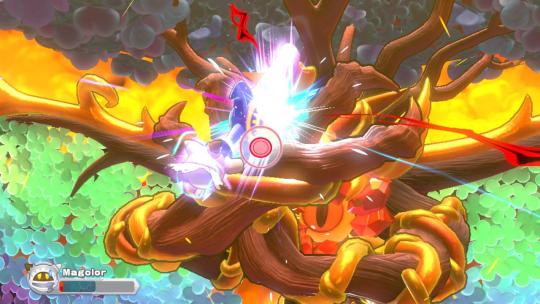
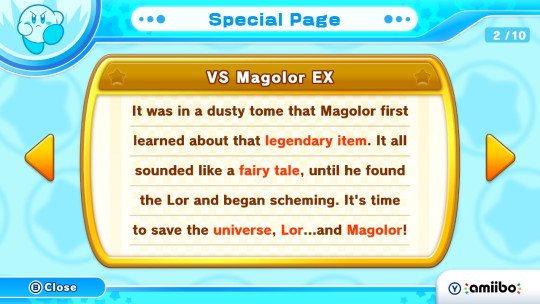
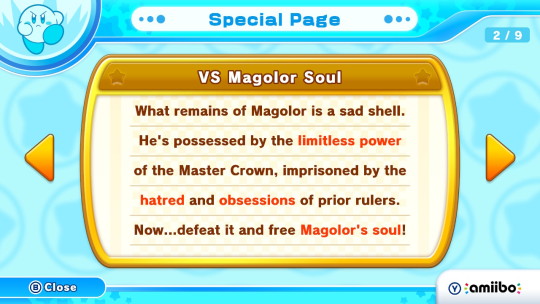
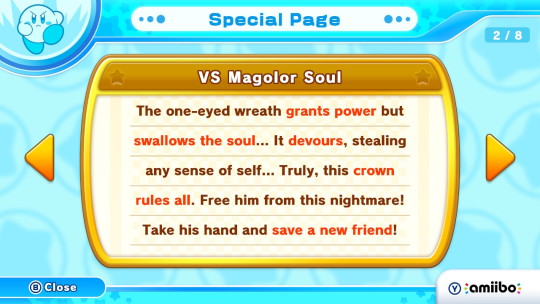
however, his christian imagery chronologically extends past the return to dreamland deluxe epilogue, as that same epilogue confirmed that "microtransagolor" (the green magolor from kirby clash deluxe) is the same magolor from return to dreamland. he nurtures the gem apple seed which he obtained after defeating the master crown in that game. clash deluxe also introduces us to a weekly "magolor day," which, you guessed it, is on sunday, with the first of them occuring on an easter.

the major reason why i connect magolor to christianity in particular rather than all abrahamic religions is the judas connection, the easter sunday thing, and the process through which he repents or "must atone for his misdeeds." while genesis isn't exclusive to christianity, the specific actions which magolor takes along his path of betrayal and redeption mirror make more sense to me as a christian moral tale rather than judaic or islamic for some reason. not sure why, i'd have to unpack that elsewhere.
this isn't to say that kirby is indoctrinating children into christianity or whatever ofc. considering the whole hyness and mage sisters deal in star allies, the connection between kirby and religion as a whole isn't always a positive one. nintendo also tends to avoid real life religions and references to them as a whole in their games likely to avoid controversy and to make their games accessible and understandable to a worldwide audience with a wide variety of cultural backgrounds. that last point is WHY i find it super crazy that magolor has an obviously and intentionally christian narrative.

(also, for the books, i'm not catholic. but 4 years of catholic school and one very catholic grandmother gives me just enough background on the topic to relate it to kirby)
48 notes
·
View notes
Note
Seeing your answered ask about metas makes me want to share this list someone made about ORV’s literary references: https://twitter.com/Jomeimei421/status/1806147303004336632
I think this same person also said something about ORV being a blend of low-brow fiction and high-brow literature and I agree. I would like to see a legitimate academic paper referencing or breaking down ORV, and now that I think about it, maybe this has already happened and I just don’t know how to find something like that.
This list is honestly such a great resource, thanks for sharing :)))) <3333
I would add the samguk yusa and samguk sagi to this list tho, even though the references might count as 'myths' or an oral tradition that's the nature of the older historical texts. I think I have a couple breakdowns of the references to the Samguk yusa, a post about ljh's name and the historical ancestors referenced, and some stuff about JttW.
In the concept of high brow and low brow, I agree that ORV is very good at being like very respectful of anything that is a 'story' and I think good at portraying the sort of 'character' that some genres or reading types represent. I think one of my posts is definitely about how the KDJ relationship with his mom is very representative of the sort of evolution of webnovel culture out of classical literature and trauma literature scenes in the sort of 'professional,' established Korean publishing. Also as a Naruto guy I really respect the JttW arc for being like 'hey all middle grade action stories and shounen a little bit comes from JttW tbh.' I also think the premise of ORV is great as sort of the natural conclusion to like American gods or Rick Riordan type justifications for all religions being true bc people believe them: ok, then here's also one man's favorite anime boy being real because he believes in him and he's actually going to punch God now. Oh also a literary reference I guess is that metatron and etc are from the Talmud rabbinic scriptures. Though I think myths about him are mostly from kabbala / oral tradition (which stems from Judaism but even now there are Jewish people who think it's very wrong to call them Jewish beliefs. Part of that is probably that in more modern history kabbala has partially been developed and sort of appropriated by non-jewish people in a way that is kind of similar to orientalizing / mysticizing the more 'normal' Judaic beliefs practiced by wider Jewish communities ((think tiktokkers who are like I Am a Witch doinG Qabala but actually she's basically just writing creepypasta in her brain about things other people actually believe in that she knows nothing about)). At the same time, there is kabbala that naturally developed from people Jewish faith in the same way orphism or other 'occult' beliefs developed out of governmentally/societally enforced/accepted Greek and Roman religions throughout history. Fun fact: Sefer ha-bahir is apparently an influential text in the development of og kabbala and apparently literally describes the idea of transmigration so that is fun.)
Ok besides the historical stuff the media on the list I'm actually exposed to is just Han Kang and then Naruto (I watched some of one piece in middle school but retained very little of it tbh I just know who some of the guys are. Actually I just had a dream where I complimented a guy's one piece shirt and then he asked me if I liked the anime and I had to be like oh... No).
I did some research on YSA's reading 'taste' though and I think it's very fitting because they're realistic books with "literary value" that are like very relevant to society but obscure enough that you wouldn't make up reading them just to impress someone, unlike Han Myungoh claiming 'art of war' is his fave book (that's another lit reference in there somewhere I think? I just remember finding it fitting... It's the type of fit for business men who want to seem macho and smart but actually don't enjoy reading at all... I would say if they said three kingdoms was their favorite I would at least believe they read it or saw an adaptation but like art of war just isn't really a Story it's more like self help? Like there are stories but they're showing 'lessons' about war lol.)
#Anyway I'd love to write a paper about like the historical literary references in particular bc tbh old old books are my special interest#but literally I need to go pick up a moving truck today and then move all my shit and I'm not even done with packing waah...#if you wanna shoot me another ask tho i love getting them bc it gives me something to focus on while my meds are kicking in in the morning#ask#anonymous#orv#orv meta
17 notes
·
View notes
Text

Went to the North Carolina Museum of Art and it was wonderful and had a whole exhibit of Judaic art and I literally got verklempt reading absolutely everything. My Uncle would have loved it. I've never seen an exhibit like this.
28 notes
·
View notes
Note
How did you name the characters?
Mod Caide: The basic character of Jackie is one I came up with years ago, well before the current iteration of Mythos or their involvement in it, for a separate project that has since been abandoned. That version of Jackie was quite a bit different from the one we know today, including the fact that she was a woman and not a practitioner of Schrodinger's Gender. When I first attempted to write Mythos in novel form, I initially chose to have a single Human protagonist rather than pull in the other Humans from the original rp, and I decided to reuse the character of Jackie. Things developed a lot since that point, but "Jackie" works fine as a gender-neutral name, so I stuck with it as I explored Jackie's character and identity more deeply.
Mod Tag: Few know this, but Sam is a nickname for Sariel. Originally, I had the idea of a character named Sariel for a DND campaign that never happened, and then reused the name years later when Caide started this project. Sariel is a Judaic mythological figure whose story doesn't really have anything to do with Sam. I liked the more celestial feel for the character, as Sam is a healer and a helper in the story, so I kept that as his given name. However, Sariel is a bit of a mouthful, so I decided on Sam as a nickname. Mostly used as a reference to Samwise Gamgee from Lord of the Rings. They bear similar characterisitcs in my mind with their loyalty and caring nature, so the nickname just fit well.
Mod Trilo: Well, my favorite band of all time is My Chemical Romance. And I'm awful at naming characters. I pretty much just scrolled through my music library for ideas, saw the name Helena, and decided it was a nice enough name to use! Funny enough, I didn't actually like the song back then, but now it's grown on me. No doubt due to Helena the character's influence (although she has nothing to do with the song in terms of theme or anything!)
Mod Kj: Strade's name comes from a small indie horror game character. When I made him I took a lot of inspiration from the creator's art and other works.
4 notes
·
View notes
Text
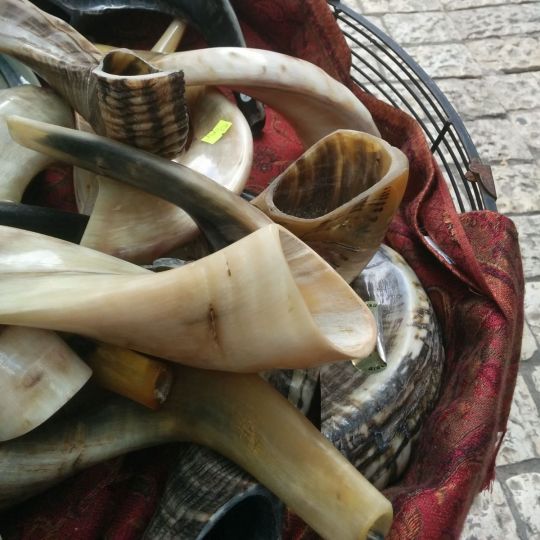
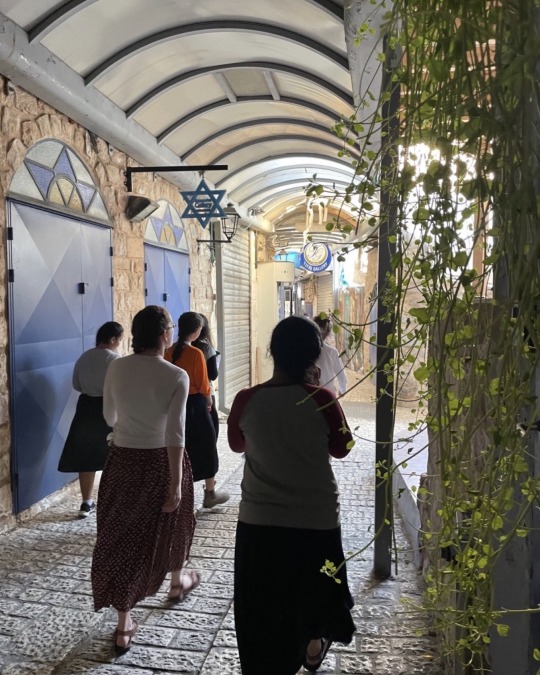

Every year before the month of Elul, I get this call to visit the Holy City of Safed. This ancient city makes me feel like a tourist and I fall deeply in love with it over and over again. Experience wondrous expeditions of paved stone alleys inlaid with beautiful art galleries and breathtaking ancient synagogues. Discover the beauty and allure of Safed to soothe your soul with holiness and radiate glowing healing energy into the world. Nurture your longing for the sacred in 5784 while wandering the old city shimmers of Light blue called תכלת. In Hebrew the word is linked to תכלית which means purpose. In the 16th century, Kabbalah mysticism was revived in Israel at the Holy City of Safed where it grew into a significant esoteric Jewish stream of profound impact, shining its sacred glow of love across the world. The Kabbalah is the most eminently sacred realm of Judaism, denoted by oneness and the longing to unite with the Holy of Holies. The Holy City of Safed Immerses your sacred soul with the holy essences of Kabbalah illuminated by the holy glow of the Zohar and the Ten Sefirot divine powers of the source. The "Ten Sefirot" known as the ten attributes of God are arranged in a Tree of Life formation, with elevated branches reaching into Heaven and roots delving deep into Earth, symbolizing the nature of God, the universe, and the human soul. Enhance the flow of holiness and oneness that enlightens a Heaven and Earth vertical alignment with Safed's ancient Synagogues and Jewish Art that glimmer holiness coded with mesmerizing Torah Biblical verses and decorated with holistic elements of Judaic holy symbols and Aramaic holy meanings. An experience designed for a loving soulful journey blessed by God's providence. Join the "Sail Away with Me" LinkedIn Group: https://www.linkedin.com/groups/9810358
#faith#sacred#holiness#holyland#jewishart#judaism#synagogue#synagogues#israel#god bless#torah#judaic#kabbalah#kaballah#kabala#ten sefirot#tree of life#holycity#holy city#galilee#mystic#esoteric#spirituality#esotericism
15 notes
·
View notes
Text
A naturalistic rendition of the nude human body, if rendered successfully, has an erotic aspect. Vasari alludes to the statue's sexual locus when he acclaims the figure's "very divine flanks". The flanks (fianchi) frame this part of the body, the nexus of its carnality. Antonio Forcellino calls the David's sexual organs "the most disquieting genitals of Renaissance sculpture", referring to the manner in which the small bulge, typical of adolescence, frames a tuft of pubic hair that "supports a penis full of energy and displays the testicles, also full of vigour". Commentators opine that the presence of foreskin on David's penis, which may appear at odds with the Judaic practice of circumcision, is in keeping with the conventions of Renaissance art.
Commentators have noted the presence of foreskin on David's penis, which may appear at odds with the Judaic practice of circumcision. An artistic deviation from what very likely would have been accurately portrayed as a circumcised penis, it is in keeping with the conventions of Renaissance art, in which the Christ Child, for example, is represented as being uncircumcised, although clearly older than the eight days compelled by Jewish scripture.

I just wanted to share that the wikipedia page for Michelangelo's David has two full paragraphs about his wee wee
4 notes
·
View notes
Text
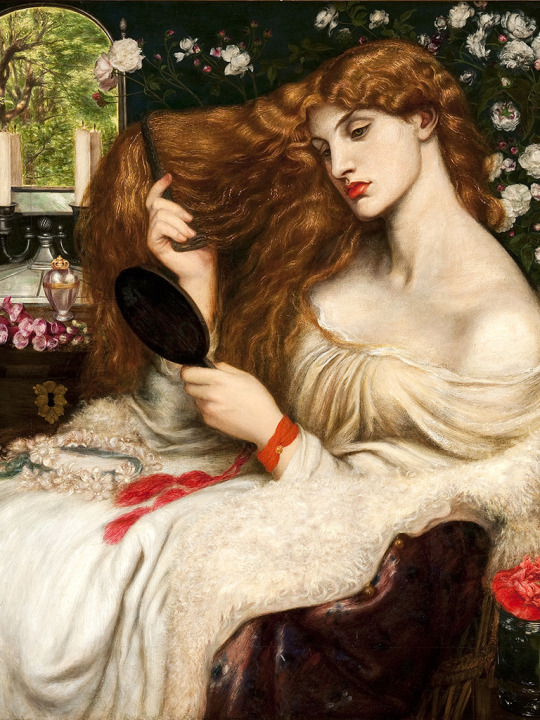
“Lady Lilith”
Painter: Dante Gabriel Rossetti Style: Pre-Raphaelite Brotherhood, Aestheticism, Oil Year: 1866-73 Themes: Beauty, Youth, Mythology Notes: Lady Lilith is an oil painting by Dante Gabriel Rossetti first painted in 1866–1868 using his mistress Fanny-Cornforth as the model, then altered in 1872–73 to show the face of Alexa Wilding. The subject is Lilith, who was, according to ancient Judaic myth, "the first wife of Adam" and is associated with the seduction of men and the murder of children. She is shown as a "powerful and evil temptress" and as "an iconic, Amazon-like female with long, flowing hair."
Rossetti overpainted Cornforth's face, perhaps at the suggestion of his client, shipping magnate Frederick Richards Leyland, who displayed the painting in his drawing room with five other Rossetti "stunners." After Leyland's death, the painting was purchased by Samuel Bancroft and Bancroft's estate donated it in 1935 to the Delaware Art Museum where it is now displayed.
The painting forms a pair with Sibylla Palmifera, painted 1866–1870, also with Wilding as the model. Lady Lilithrepresents the body's beauty, according to Rossetti's sonnet inscribed on the frame. Sibylla Palmifera represents the soul's beauty, according to the Rossetti sonnet on its frame.
A large 1867 replica of Lady Lilith, painted by Rossetti in watercolor, which shows the face of Cornforth, is now owned by New York's Metropolitan Museum of Art. It has a verse from Goethe’s Faust as translated by Shelley on a label attached by Rossetti to its frame:
"Beware of her fair hair, for she excells All women in the magic of her locks, And when she twines them round a young man's neck she will not ever set him free again."
More: Lady Lilith
5 notes
·
View notes